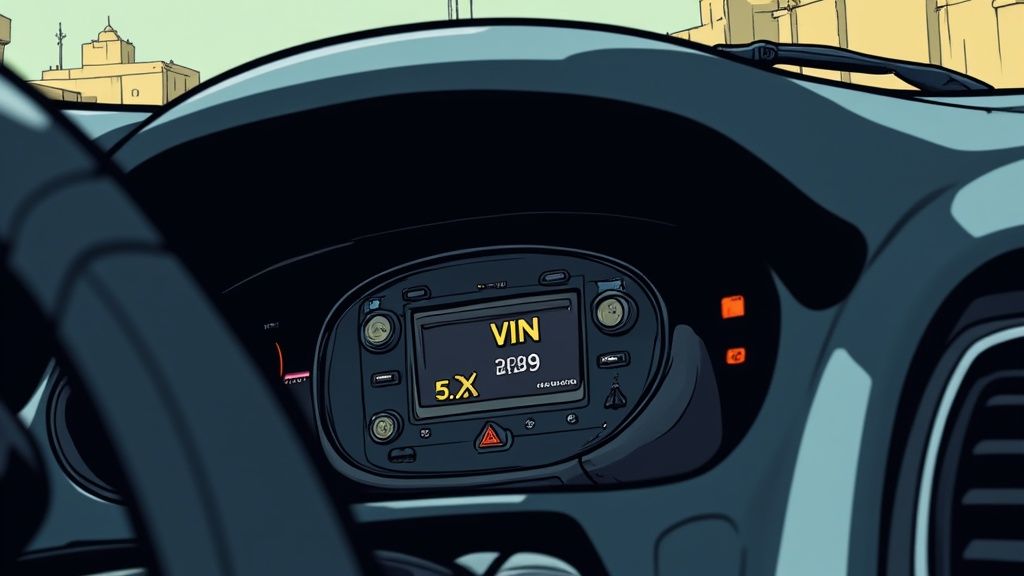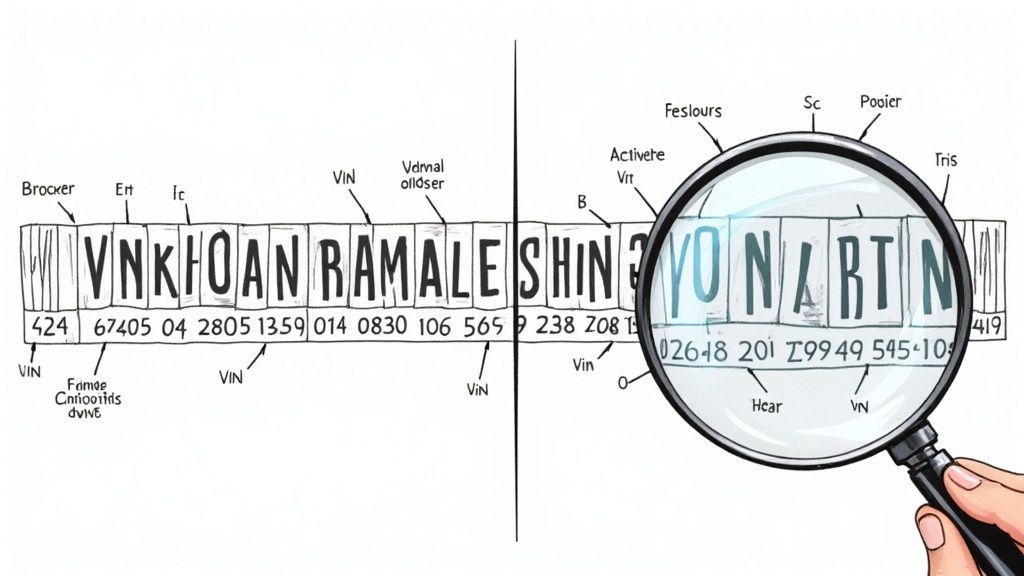
How to Decode VIN Number: Your Expert Guide to Understanding Vehicle History
The Evolution of Vehicle DNA: Understanding VIN Systems

Just as DNA contains the genetic code that makes us unique, a Vehicle Identification Number (VIN) serves as a car’s unique fingerprint. This code holds essential details about a vehicle’s history, specifications, and identity. However, the VIN system we know today emerged from decades of development and refinement.
From Chaos to Standardization: The Need for a Universal Language
Before 1981, tracking vehicles was remarkably challenging. Each manufacturer used their own format for identification numbers, making it nearly impossible to maintain consistent records across different organizations. For example, law enforcement struggled to track stolen vehicles, while insurance companies had difficulty assessing vehicle histories accurately.
The automotive industry recognized this problem needed solving. In the 1950s and 1960s, VINs were typically 8-10 characters long, providing basic information like model year and assembly plant location. But this wasn’t enough. The National Highway Traffic Safety Administration (NHTSA) stepped in and mandated a standardized 17-digit VIN for all vehicles manufactured after 1981. This change brought consistency and reliability to vehicle identification. Learn more about VIN standardization
The Impact of Standardization: A New Era of Automotive Transparency
The introduction of the 17-digit VIN system created clear benefits for everyone in the automotive industry:
- Manufacturers: Better control over inventory tracking and simplified recall management
- Law Enforcement: More effective vehicle theft recovery and accident investigation
- Consumers: Easy access to detailed vehicle histories before making purchases
This standardized approach to vehicle identification helps protect buyers and sellers alike. Whether you’re shopping for a used car or investigating an accident, the VIN provides reliable information about a vehicle’s background. Understanding how to read these numbers gives you the knowledge to make smarter decisions about vehicle ownership.
Mastering the 17-Digit Code: A Position-by-Position Analysis
Every vehicle has a unique 17-digit code that tells its complete story. Understanding how to read this Vehicle Identification Number (VIN) gives you essential details about any car’s background, specifications, and history. Let’s break down each section to see what these numbers and letters really mean.
Unpacking the World Manufacturer Identifier (WMI)
The first three digits make up the World Manufacturer Identifier (WMI). This section tells you where and by whom the vehicle was made. For example, if a VIN starts with “1”, you know the car was built in the United States. The second and third characters point to the specific manufacturer, giving you a clear picture of the vehicle’s origins.
Decoding the Vehicle Descriptor Section (VDS)
Characters 4 through 9 form the Vehicle Descriptor Section (VDS), which reveals key details about the vehicle’s features:
- Vehicle Type: Car, truck, SUV, etc.
- Model and Series: The specific model line and generation
- Body Style: Sedan, coupe, convertible, etc.
- Engine Type: Information about the power plant
- Safety Features: Details about airbags and other protection systems
This section helps you understand exactly what kind of vehicle you’re dealing with and makes finding compatible parts much easier.
Unraveling the Vehicle Identifier Section (VIS)
The final eight characters make up the Vehicle Identifier Section (VIS). This unique combination includes:
- Model Year: Character 10 shows when the car was made using a specific pattern. Letters B through Y match years 1981-2000 (excluding I, O, Q, U, Z), numbers 1-9 cover 2001-2009, and the alphabet starts over from A in 2010. Learn more about VIN decoding
- Assembly Plant: Character 11 tells you which factory built the vehicle
- Serial Number: The last six digits give the vehicle its unique identity
You might be interested in: How to master your vehicle maintenance records to help track your car’s service history alongside its VIN information.
Putting It All Together: The Power of VIN Decoding
Reading a VIN helps you verify a vehicle’s authenticity, check its history, and ensure you’re getting the right parts. Whether you’re shopping for a used car or just want to know more about your current vehicle, understanding the VIN gives you valuable information about its background and specifications.
Essential Tools and Resources for Professional VIN Analysis

While manual VIN decoding provides basic vehicle information, professional tools and resources are essential for getting the complete picture. These tools help you uncover critical details about a vehicle’s history and specifications with greater accuracy.
Free VIN Decoder Websites: A Quick First Look
Free online VIN decoders are a good starting point for basic vehicle information. These tools quickly tell you key details like the manufacturer, model year, and where the vehicle was made. Keep in mind that free services typically don’t provide deeper information like specific trim packages or detailed history records. You’ll need additional resources for a thorough analysis.
Paid VIN Check Services: Unlocking Comprehensive Vehicle Histories
For detailed vehicle history, services like Carfax and AutoCheck are worth the investment. These platforms tap into extensive databases to show accident records, ownership changes, title status, and odometer readings. For example, you can quickly spot if a car has been in a major accident or has title issues - information that’s crucial for assessing its true value.
Manufacturer-Specific Databases: Accessing Deeper Insights
Car manufacturers maintain detailed records of their vehicles, including build sheets, recall notices, and warranty information. While these databases often have restricted access, they’re valuable resources when available. Some companies give limited access to vehicle owners or authorized dealers, providing specific details about original equipment and service history.
NICB VINCheck: Protecting Yourself Against Fraud
The National Insurance Crime Bureau (NICB) offers a free VINCheck tool specifically focused on identifying stolen vehicles. This resource helps protect buyers from fraud by checking if a vehicle has been reported stolen or branded as salvage due to severe damage like flooding.
Building Your VIN Decoding Toolkit
A complete VIN analysis requires multiple tools working together. Start with a free decoder for basic details, then use a paid service for history reports, and check manufacturer databases when possible. Consider adding Auto Service Logger to track maintenance records alongside your VIN analysis. This approach gives you the most accurate and complete picture of any vehicle you’re researching.
Overcoming Common VIN Decoding Challenges

While decoding a VIN is usually simple, certain situations can make it tricky. Let’s explore the most common VIN decoding challenges and practical ways to solve them. Having a system like Auto Service Logger makes it easier to store and track this important vehicle information once decoded.
Damaged or Illegible VIN Plates
Weather exposure, accidents, and normal wear can make VIN plates hard to read. Corrosion and physical damage are the most frequent causes of illegible VINs. Fortunately, there are several ways to retrieve this vital information:
- Check Multiple Locations: Look beyond the dashboard - check the driver’s doorjamb, under the hood, and your vehicle paperwork
- Make a Rubbing: For faint numbers, place paper over the VIN and gently rub with a pencil to reveal the characters
- Get Professional Help: Vehicle inspectors and DMV officials can assist with difficult-to-read VINs
These methods help ensure you can properly document your VIN in Auto Service Logger for future reference.
Discrepancies Between VIN and Documentation
Finding differences between the VIN on your vehicle and your paperwork is concerning. This mismatch could indicate simple clerical errors or more serious issues like fraud. Here’s what to do:
- Review All Documents: Look carefully for typing mistakes or recording errors in the paperwork
- Talk to Previous Owners: They may know about documentation issues or can provide clarity
- Contact Authorities: If you suspect fraud, file a report immediately - mismatched VINs are serious
Recording verified VIN information in Auto Service Logger creates a reliable record to protect against future discrepancies.
Decoding Older VINs (Pre-1981)
Vehicles made before 1981 used different VIN formats that varied by manufacturer. These older VINs are often shorter and follow different patterns than today’s standardized 17-digit codes. To decode them:
- Use Manufacturer Resources: Check with the vehicle maker for specific decoding guides
- Try Special Decoders: Some online tools focus on classic car VINs
- Connect with Experts: Car clubs and vintage vehicle forums often have members familiar with older VIN systems
Even for classic cars, keeping accurate VIN records in Auto Service Logger helps preserve your vehicle’s history and value.
Identifying Potential VIN Tampering
VIN tampering is illegal and buyers should know how to spot signs of manipulation. When examining a vehicle:
- Study the VIN Plate: Watch for scratch marks, mismatched text styles, or odd rivets
- Check All VIN Locations: Numbers should match exactly across all spots
- Use NICB VINCheck: This free tool reveals if a vehicle has been reported stolen or salvaged
Storing your verified VIN in Auto Service Logger provides a secure backup and helps protect against fraud. Taking these steps helps ensure smooth vehicle ownership and proper documentation.
Making Smart Vehicle Investments With VIN Intelligence
A VIN number contains vital information that can help you make better vehicle buying decisions. Smart buyers use VIN analysis to spot problems early, negotiate better prices, and avoid costly mistakes. Understanding how to use this data effectively can transform your approach to vehicle purchases.
Red Flags: Finding Hidden Problems
The VIN acts like a detailed history book for any vehicle. By decoding the VIN, you can uncover critical issues that may not be obvious during a standard inspection. This includes past accidents, title problems (like salvage status), and potential odometer fraud. Finding these issues early lets you either negotiate a more reasonable price or avoid a problematic purchase altogether. When you have concrete data about a vehicle’s past, you’re in a much stronger position during price negotiations.
Vehicle History Verification: Research That Pays Off
Want to confirm what a seller tells you? The VIN provides independent verification. You can check the vehicle’s history through services like Carfax or AutoCheck to get an objective record of its past. The National Insurance Crime Bureau’s VINCheck service adds another important safety check by revealing if the vehicle was reported stolen. This thorough background check helps protect your investment from vehicles with questionable histories.
Strategic Evaluation: Making Data-Driven Choices
Professional car dealers succeed by using solid data, not hunches. You can adopt this same approach by making VIN decoding a key part of your evaluation process. Start with basic information from a free VIN decoder, then invest in a comprehensive history report for deeper insights. Keep track of your findings using a service like Auto Service Logger. This systematic method helps you evaluate each vehicle objectively, just like experienced dealers do. Think of it as building a complete file for each potential purchase.
Investment Protection: Negotiating With Confidence
Having detailed VIN information gives you real power at the negotiating table. When you discover issues through a VIN check, you can discuss them specifically with the seller and adjust your offer accordingly. For example, if you find evidence of previous damage, you can calculate a fair price that accounts for this history. This informed approach often leads to significant savings and helps prevent expensive surprises after purchase. Smart buyers use VIN data to ensure they pay an appropriate price for every vehicle they consider.
Maximizing Value Through Strategic VIN Implementation
Understanding your vehicle’s VIN number is key to making smart ownership decisions and getting the most from your investment. Smart vehicle owners use VIN information not just for basic details, but to guide maintenance, find the right parts, and keep detailed records that preserve their vehicle’s value.
Streamlining Maintenance With VIN Precision
When you need maintenance or repairs, your VIN helps ensure everything is done correctly the first time. Rather than guessing about specifications, the VIN provides exact details about your vehicle’s components and systems. This precision prevents costly mistakes from using the wrong parts and helps you follow the ideal maintenance schedule for your specific model. Following VIN-guided maintenance schedules protects your vehicle’s longevity and performance.
Finding the Right Parts Every Time
Your VIN acts like a personalized parts catalog, taking the uncertainty out of ordering components. For instance, when replacing engine or transmission parts, even small variations between models can cause major problems. By using your VIN to identify parts, you avoid compatibility issues that could damage your vehicle or require expensive fixes later.
Tracking Warranty Coverage and Safety Recalls
The VIN is your key to accessing important warranty information and staying on top of safety recalls. When dealing with warranty claims, your VIN provides definitive proof of coverage eligibility. You can also quickly check if any recalls affect your vehicle - addressing these promptly keeps you and your passengers safe while maintaining your car’s reliability.
Building Value Through Detailed Service Records
A complete service history linked to your VIN makes your vehicle more valuable when it’s time to sell. Auto Service Logger makes it simple to maintain thorough maintenance records, documenting every service performed on your vehicle. Buyers appreciate seeing this level of detail and care, which can translate to a higher resale price.
Making Smart Upgrade Decisions
Your VIN helps guide smart choices about vehicle modifications. For example, when upgrading your stereo system, VIN-based specifications tell you exactly which components will work with your car’s existing setup. This targeted approach to upgrades helps you avoid wasting money on incompatible parts while getting the improvements you want.
Ready to take control of your vehicle’s maintenance and protect its value? Auto Service Logger provides one central place to store and manage all your vehicle records and VIN information. Start maximizing your investment today! Learn more about Auto Service Logger and sign up.